Not a catchy name is it? Although FMS-F5 doesn’t exactly roll off the tongue like warm velvet and probably brings to mind images of cold war jet fighters rather than idyllic camp spots, you shouldn’t let that put off. Name aside, the FMS-F5 is a very light and very compact liquid fuel (that’s petrol to you) stove that costs considerably less than most.
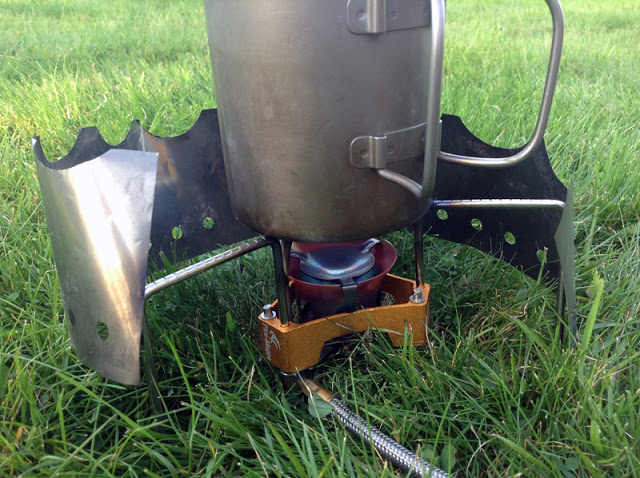 |
| The supports will just about hold a 400ml mug if you’re careful. |
Why petrol? It’s a good question and the answer will only really make sense to those travelling in the more remote regions of our little planet. If you’re never going to venture further than Wrexham, then in all honesty, I wouldn’t bother. However, those who do find themselves at the far end of back and beyond will be heartened to know that, no matter what things you can’t buy there, chances are you’ll always be able to source some petrol, kerosene or diesel. Another group who may appreciate a petrol stove are those who require something that will continue to function as the temperature drops well below what we might consider ‘chilly’.
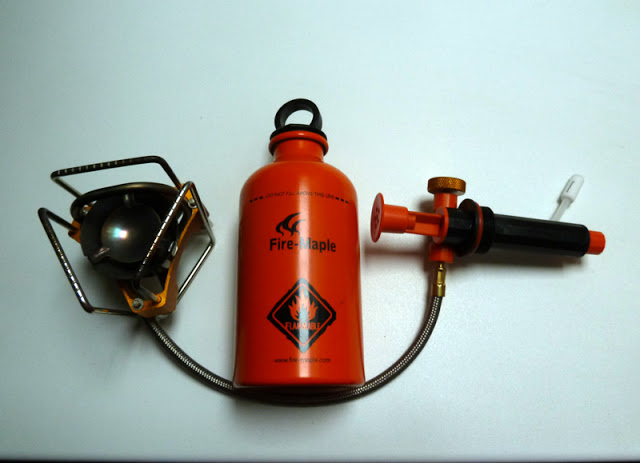 |
| Stove, bottle, pump. The three elements of any petrol stove. |
Like most petrol stoves, the FMS-F5 consists of a burner unit, a pump and a fuel bottle. Fold out the three supports on the burner, screw the fuel bottle onto the pump and you’re good to go. The first job is the pressurise the fuel bottle with, you guessed it, the pump. Around 20 strokes should be sufficient to build up pressure if the bottle’s reasonably full but you might need a few more if the fuel level’s running low. There’s no pressure gauge or visual indicator but you’ll very quickly get a feel for it as the pump plunger become increasingly stiff as the pressure builds.
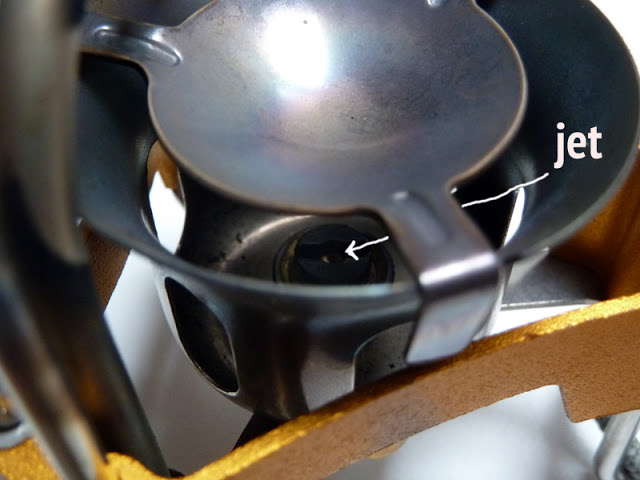 |
| Fuel jet. Fuel comes out, light it through one of the cut-outs and wait a minute for everything to warm up. |
Your next job is to prime the stove by releasing a SMALL amount of fuel through the jet at the base of the burner. Slowly unscrew the valve on the pump until you see a SMALL amount of fuel coming through the jet, then close the valve. By SMALL, I mean a few ml, it won’t be any faster, quicker or better in any way if you put more fuel through. The stove doesn’t have any form of ignition so you’ll need a lighter or similar. The fuel may look hard to reach but remember, this is petrol, it’s not meths, put a flame or spark anywhere near it and I guarantee it will light instantly.
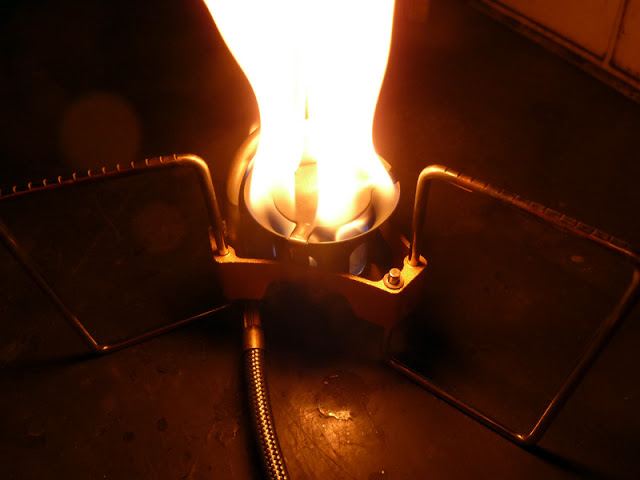 |
| This is the priming / pre-hear stage burning the fuel you initially let out of the jet. |
The purpose of priming or pre-heating as we should perhaps think of it, is to heat the fuel pipe that runs across the top of the stove. If the pipe’s hot, the fuel will vaporise as it exists the jet. Pre-heating may take a minute or so but generally by the time the flame from the priming fuel has begun to fade, everything will usually be hot enough. Now, slowly open the valve on the pump again – I’ve found that a good couple of turns are required before much happens but go slowly rather than mad. As the fuel starts to flow you should see the flame in the burner increase in size. It might surge slightly at first but should settle down quite quickly. Something else I’ve found is that the stove is quite slow to react to any adjustments you make to the valve setting. It’s not really a problem, it’s just something to be aware of. In common with many petrol stoves, the FMS uses a ‘roarer’ jet system. Why ‘roarer’? Trust me, all will become apparent and you’ll be left in no doubt about whether it’s actually burning.
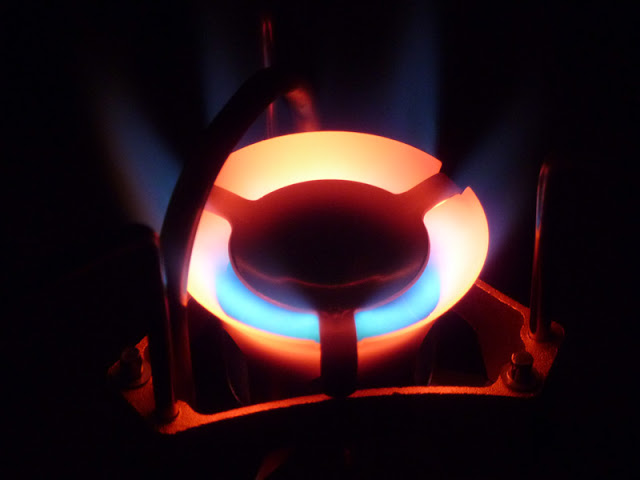 |
| Pre-heating over and cranked up and roaring – very pretty. |
So far so good then? No, not really. Now is probably a good time to mention that the very first time I used the stove, it leaked. It wasn’t anything drastic but there was a weep from the fuel pipe union where it joins the stove body. This ‘joint’ is actually a swivel and relies on two O rings to maintain the seal. There was two O rings in the spares kit that accompanies the stove, so I removed the old ones, fitted the new and all was fine.
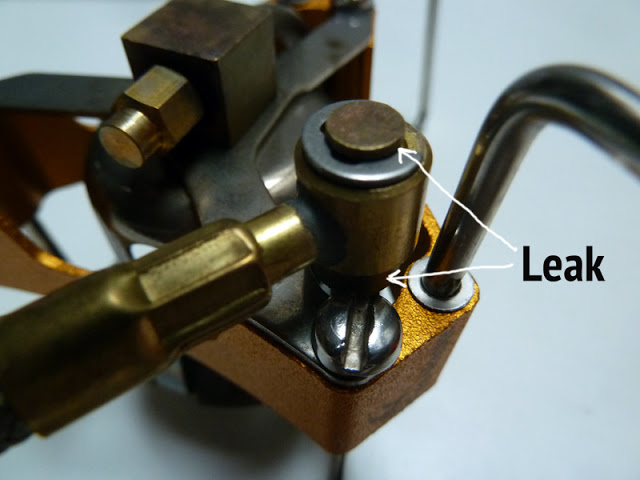 |
| Remove the C clip, lift the fitting off and beneath are the leaky O rings. |
Shortly afterwards my newly repaired stove accompanied me on a couple of days away and performed its duties fine. I did discover that the pot supports are just close enough together to hold a 400ml mug and that the stove appeared to be more fuel efficient than I’d imagined it might be; As standard it comes with a 330ml fuel bottle but bottles up to to 1L are available separately for those undertaking longer trips.
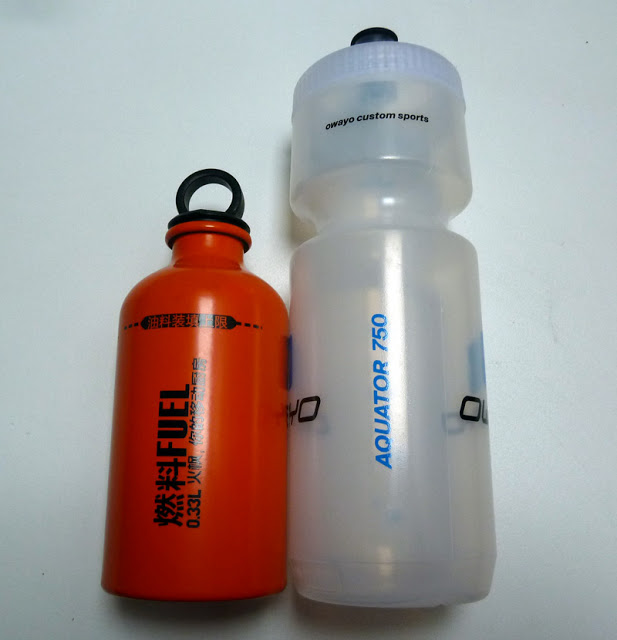 |
| 330ml bottle – it’ll last a surprisingly long time. |
I returned from my few days away feeling pretty confident that over time we’d become allies when conditions called for something a little ‘more’ than my usual meths set-up can provide. Knowing that modern petrol isn’t what it used to be, I decided to treat my new friend to 5L of Aspen 4T – a very clean burning petrol used in lawnmowers, strimmers and the like and I’m sorry to say that, it was about this time that the FMS-F5 and myself had a falling out.
The first thing that happened was the reappearance of the fuel pipe leak. Thinking that perhaps the supplied O rings weren’t the best quality and simultaneously wondering where I’d last seen my big box of potential replacements, I went to turn the fuel off. I turned the valve on the pump and turned it and turned it and turned it some more but nothing. No matter how many times I turned the valve, it never seated and therefor never shut off the fuel supply. Thankfully, we were still at the priming stage when this occurred but had the stove been up to operating temperature, then your only safe course of action would be to let the thing simply burn itself out. By my reckoning, with a full bottle that would take the best part of two hours, so not an ideal scenario.
It was fairly obvious that the valve had developed a fault. Maybe I was unlucky, perhaps it was a ‘Friday afternoon’ stove? I don’t know but I do know that petrol, especially when it’s pressurised isn’t something you take many chances with … and that’s mainly because you won’t get the opportunity to take more than one.
I said at the start that when compared to many other petrol stoves, the FMS-F5 is light, compact and relatively inexpensive but perhaps it’s time we started to ask ourselves the question ‘why is it cheap?’. More often than not, the answer is blindingly obvious but in our rush to grab a ‘bargain’ we often fail to see it. A waterproof that’s not quite as waterproof as you thought or a sleeping bag not quite as warm as you were told, those things will be disappointing but they won’t kill you, yet something like this just might.
Basically a knock off of an MSR? This thing may be half the price of an MSR, but how long will it last? My MSR Wisperlite is almost 20 years old, and is still great!
I wouldn't say it's an MSR 'knock-off', there's too many differences in the design for it to be considered a clone or copy … but yes, "how long will it last?" In this case it was a few weeks, which brings me back to the final paragraph in the review.
Here's some of the fun you can have with petrol. It contains some swearing, so not for work. Skip to around 2.20 for the pressurised bit. https://www.youtube.com/watch?v=i5ryowgcnGM
WOw I have had the Fire Maple fms f3 for about 5 years and I never had a problem with it. I have taken it all over the world and it is still working perfectly. I also have an Optimus polaris optifuel stove that I bought cause I wanted to have the option of gas canisters in the same stove but I do love my old fire maple. Did you check all is screwed correctly?